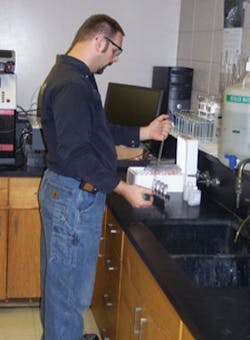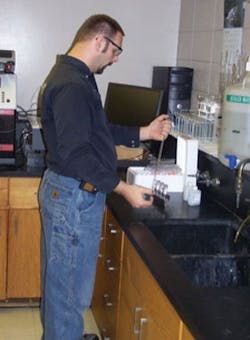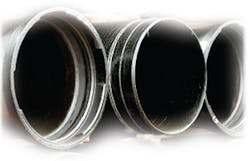New Lab Techniques Help Plant Achieve Timely Process Control
By David MacDonald
Wastewater treatment plant laboratories must regularly run a series of locally and federally mandated tests, representing a considerable portion of a lab's workload. With regulatory based testing demanding such significant time and personnel resources, where does testing for process control optimization fit in? Somewhere in the lab's schedule, time must be allotted to testing for process control purposes. However, when the tests are time and labor intensive, they often take a back seat to permit testing.
Lab staff at the Grandville, MI, Wastewater Treatment Plant now use prepackaged vial chemistries to streamline ammonia and phosphorus analysis for process control and permit reporting.
The Grandville Regional Clean Water Plant (Grandville, MI), a 4.4 mgd conventional activated sludge plant serving approximately 70,000 customers, experienced this issue, especially with its phosphorus and ammonia testing. Both tests were long and tedious, making it difficult to perform them as often as necessary for reliable process control. Recently, adopting new testing techniques has helped the Grandville treatment plant transition phosphorus and ammonia testing from a once or twice a week chore to a quick daily function that provides timely, accurate data for process control and permit reporting.
Ascorbic Acid Test
For years, the Grandville plant conducted phosphorus testing using the standard ascorbic acid test. It took a full day to complete the test, including preparation of the reagents, digestion of the sample, cooling of the sample, titration to adjust pH (twice), addition of reagents, and the reaction time.
"The ascorbic acid test is extremely time consuming," said Tom Syswerda, lab technician for the Grandville treatment plant. "You can't walk away from it and multi-task, either. You have to keep an eye on it the whole time, particularly during the digestion process, because some flasks are thicker than others or certain spots are hotter than others. You also have to titrate every sample twice to get the pH right, once for digestion and once to bring the pH back up to run the reagent. Plus, you're running several samples, which adds up to even more time."
The practical effect was that the test procedure was time prohibitive, particularly for a smaller plant with limited personnel. The Grandville plant could perform the test only once a week, due to time constraints. This once-a-week schedule provided very little value from a process control perspective because operators could not rely on the outdated data.
Ammonia Testing
In addition, the Grandville treatment plant was experiencing problems with their ammonia testing. The plant was using an Ion Selective Electrode (ISE) that operated on a curve established by running a blank and two standards (each within a certain tolerance of the other).
"Maintaining the curve was very difficult," Syswerda said. "By the time we were done running our finals, we had to re-check the ISE curve by running another standard. If it was out of line we'd have to recalibrate the probe."
In addition to these issues, Syswerda and other operators constantly had to monitor and change membranes on their ammonia ISE. The actual test was also time consuming, taking up to three hours to complete and requiring continuous supervision.
"I couldn't leave the test." Syswerda said. "I had to just sit and monitor it as it processed. If I got called away, I'd lose the curve and would have to start over."
The instability of the ammonia probe combined with the significant amount of time required to complete sample testing made this an inefficient procedure for monitoring ammonia. As a result, the plant was forced to relegate ammonia testing to only twice a week.
Prepackaged Vial Chemistries
From an operation's perspective, phosphorus and ammonia testing was too infrequent at the Grandville plant to provide adequate information for process control purposes. Ferric chloride is fed into the end of the plant's secondary process to facilitate phosphorus removal. If the plant received an unexpected high load (a "slug") of phosphorus, they were often too late in identifying the spike and initiating an increase in ferric dosage to alleviate the problem. Similarly, the twice a week ammonia testing provided less than adequate data for adjusting aeration for more optimized ammonia removal.
In early 2008, the Grandville treatment plant laboratory began using prepackaged vial chemistries to streamline chemistry analysis for process control. By adopting these new methods, time for running an ammonia test has decreased from three hours to just 20 minutes. Phosphorous testing has decreased from an all day procedure to only about an hour and a half.
"This has allowed us to run these tests every day, giving us a more timely idea of loadings entering the plant and how the plant is performing, and thereby permitting closer operational control of the treatment process," Syswerda said. "We are now able to much more quickly respond to changes in our system and adjust treatment processes accordingly."
Freeze-Dried Reagent/Barcode Scanning
For ammonia testing, the new prepackaged vial chemistry technique adopted by the plant is the Hach TNTplus™ ammonia test. This prepackaged test includes bar-coded vials with special caps that contain a single dose of integrated freeze-dried reagent.
Using a Tensette® pipet, 0.5 ml of sample is added to the vial, then the foil top from the Dosi-Cap Zip™ is removed and the cap is secured to the vial. After shaking the vial to dissolve all the contents of the reagent into the sample, it's then inserted into the plant's Hach DR 2800™ Portable Spectrophotometer. The instrument spins the vial twice. With the first spin, the instrument reads the bar code and identifies the correct parameter, method and wavelength for the test. On the second spin of the vial, the instrument takes 10 readings and displays the average on the screen. Outliers due to fingerprints or other flaws, if present, are automatically rejected in this average.
The 4.4 MGD Grandville Regional Clean Water Plant in Grandville, MI.
"The test is extremely fast and accurate," Syswerda said. "After initially running this method against our ammonia ISE in numerous side-by-side tests, we gained complete confidence in the ammonia TNTplus reagents. We now use our ISE only as a back up tool."
By switching to the new platform, the plant can now monitor ammonia levels on a daily basis. As a result, the plant can operate more efficiently and has the ability to detect and neutralize high influxes of ammonia in a timely manner.
Streamlining Phosphorus Testing
The Grandville treatment plant now uses Hach TNT (Test 'N Tube™) reagent sets for their Total Phosphorus needs.
The standard TNT Phosphorus test incorporates PermaChem™ "Powder Pillows;" reagents in pre-dosed form. The prepackaged reagent set includes phosphate reagent pillows, potassium persulfate pillows, sodium hydroxide solution, total and acid hydrolyzable test vials, and deonized water.
To run the test, samples are prepared and added to the TNT vials. Samples undergo a 150° F acid persulfate digestion for 30 minutes. Once the samples cool, the phosphate reagent is added. After the samples react for two minutes, the vials are read on the plant's DR 2800 Portable Spectrophotometer or on one of their DR/800™ series colorimeters.
Efficiency Gained
The prepackaged vial chemistries have been a welcomed change to the testing techniques and testing schedule of the Grandville plant. Costs for the tests are a bit more than making reagents from scratch, Syswerda said, but in a lab with limited personnel, the time saved at the Grandville plant adds up to the difference between testing daily or testing weekly.
"The benefits far surpass the costs," he said. "Quick, accurate daily testing not only equals better process control, it makes our lab more efficient." WW
About the Author:David MacDonald is associate product manager for lab chemistry at Hach Company, headquartered in Loveland, CO. He holds a BS in chemistry with research expertise in environmental analyses using microfluidic devices.
More WaterWorld Current Issue Articles
More WaterWorld Archives Issue Articles


